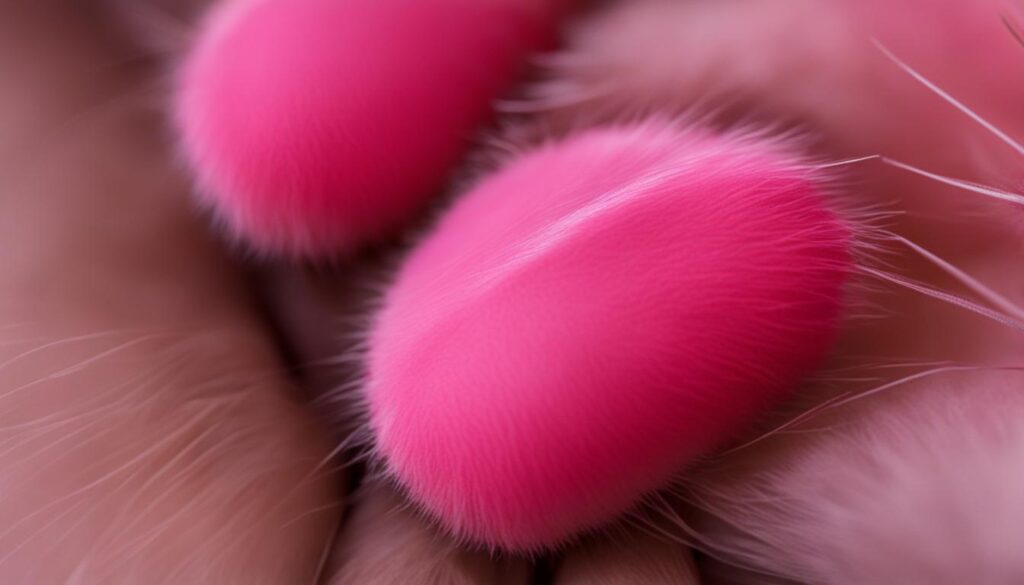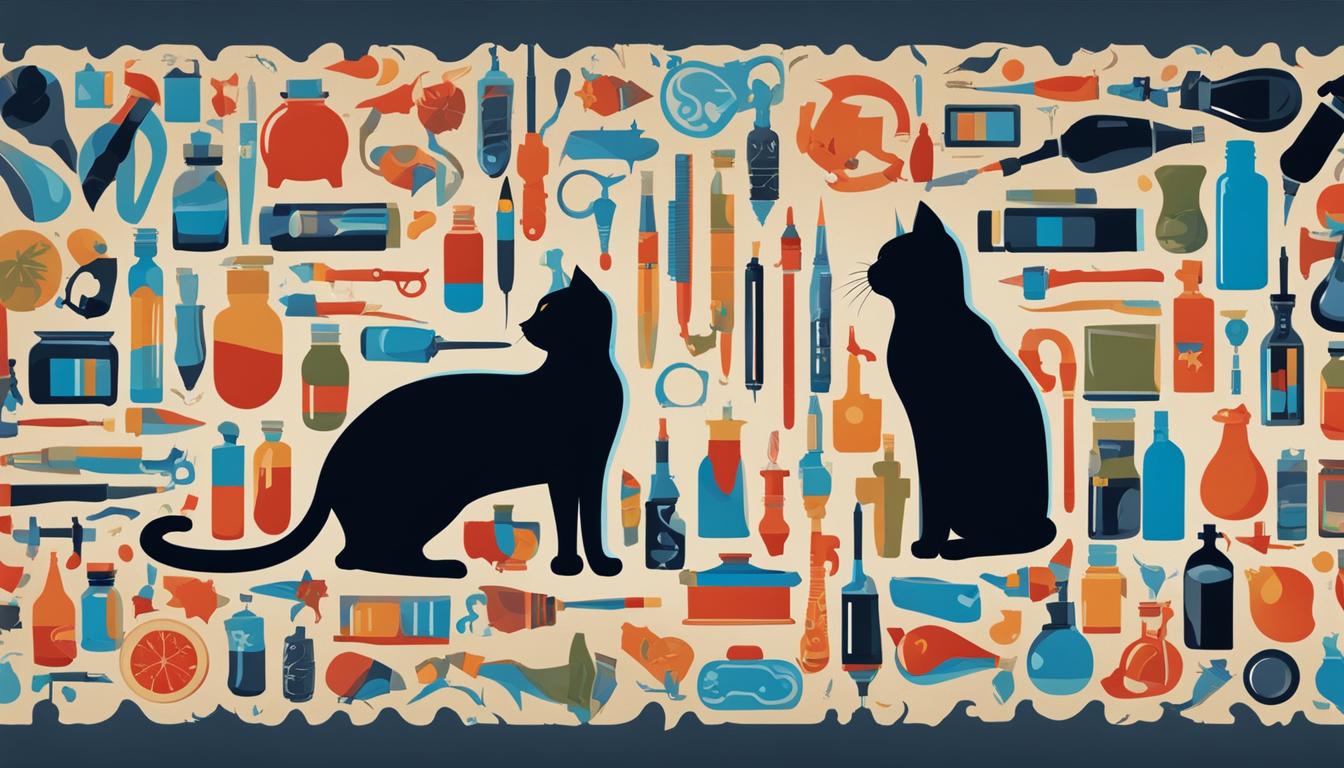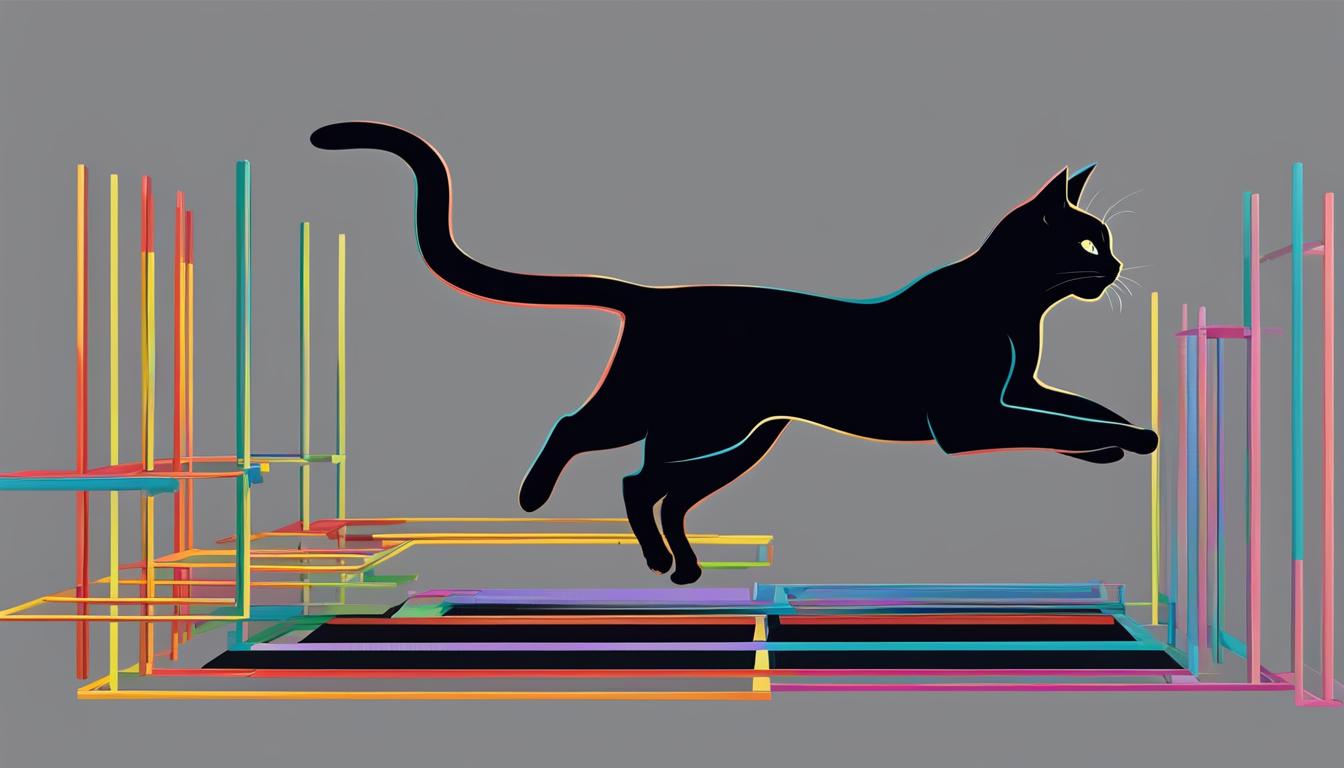Hey there, fellow cat lovers! Today, I want to dive into the fascinating world of feline diabetes. Cats, just like us humans, can also be affected by this condition where their bodies struggle to produce enough insulin to balance their blood sugar levels. But fear not! With a little knowledge and a lot of love, we can help our furry friends manage this condition and live their best lives.
So, what are the symptoms of diabetes in cats? Keep an eye out for increased thirst, frequent urination, weight loss, and an insatiable appetite. These signs may indicate that your precious feline is struggling with diabetes. But relax, understanding the causes and seeking appropriate treatment can make a world of difference. Let’s explore further, shall we?
Key Takeaways:
- Feline diabetes occurs when cats are unable to produce enough insulin to balance their blood sugar levels.
- Symptoms may include increased thirst, frequent urination, weight loss, and increased appetite.
- Obesity is often the main cause, but genetics can also play a role.
- Treatment typically involves insulin therapy and a low-carbohydrate diet.
- Regular monitoring by a veterinarian is crucial for proper management.
Signs of Feline Diabetes: Recognizing the Symptoms
Feline diabetes can manifest through various signs that cat owners should be aware of. Recognizing these symptoms is crucial for timely diagnosis and treatment. The main signs include increased thirst, increased urination, weight loss, and increased appetite. Cats with diabetes tend to drink significantly more water than usual, and they may use the litter box more frequently due to increased urine production.
Increased appetite is often seen in diabetic cats because their bodies are unable to utilize glucose properly, resulting in an energy deficiency. As a result, cats may eat more to compensate for the lack of energy. It’s important to note that while these symptoms are commonly associated with feline diabetes, they can also indicate other underlying health issues. Therefore, it’s essential to consult a veterinarian for a proper diagnosis.
“I noticed that my cat, Mittens, started drinking water excessively and urinating more frequently. She also seemed to be losing weight despite having a ravenous appetite. I took her to the vet, and she was diagnosed with diabetes. It was a relief to know what was causing her symptoms, and we were able to start her on insulin therapy right away. Mittens is now doing much better and lives a happy, fulfilling life with proper management of her diabetes.” – Cat owner testimonial
Recognizing the signs of feline diabetes is the first step towards ensuring your cat’s well-being. If you notice any of these symptoms, it’s important to seek veterinary care promptly. Early diagnosis and treatment can help manage the condition effectively and improve your cat’s quality of life.

| Signs | Common in Diabetic Cats | Less Common or Absent in Diabetic Cats |
|---|---|---|
| Increased thirst | ✓ | |
| Increased urination | ✓ | |
| Weight loss | ✓ | |
| Increased appetite | ✓ | |
| Vomiting | ✓ | |
| Lethargy | ✓ | |
| Poor coat condition | ✓ |
This table provides a comparison of symptoms commonly seen in diabetic cats. While increased thirst, increased urination, weight loss, and increased appetite are typical signs, it’s essential to consider other symptoms that may be present or absent. Consulting a veterinarian is crucial for an accurate diagnosis and appropriate treatment plan.
Managing Feline Diabetes: Diet and Insulin Therapy
Feline diabetes requires a comprehensive approach to management, focusing on both diet and insulin therapy. A key component of managing this condition is implementing a low-carbohydrate diet, which helps control blood sugar levels and promotes better overall health for diabetic cats. By reducing the intake of carbohydrates, specifically simple sugars, the body’s demand for insulin is minimized, leading to more stable blood sugar levels.
Insulin therapy plays a crucial role in the treatment of feline diabetes. Most often, owners are responsible for administering insulin injections to their cats. It is essential to follow the veterinarian’s instructions carefully and adhere to the recommended dosage and frequency. Regular monitoring of blood sugar levels is necessary to determine the effectiveness of the insulin therapy and make any necessary adjustments to the treatment plan.
Monitoring Blood Sugar in Cats
Monitoring blood sugar levels in cats with diabetes is crucial for ensuring their well-being. This can be done through regular at-home glucose testing using a glucose meter specifically designed for feline use. The veterinarian will provide guidance on how to perform these tests and interpret the results. The frequency of testing may vary depending on the individual cat’s condition, but typically includes regular measurements before meals and insulin administration.
In addition to at-home monitoring, regular veterinary check-ups are essential for cats with diabetes. These appointments allow the veterinarian to assess the cat’s overall health, monitor blood sugar levels, and make any necessary adjustments to the treatment plan. The veterinarian may also perform additional tests, such as fructosamine or glycosylated hemoglobin, to evaluate long-term blood sugar control.
Table: Comparison of Different Feline Diabetes Diets
| Diet Type | Description |
|---|---|
| Low-carbohydrate | Emphasizes the reduction of carbohydrates, especially simple sugars, to help control blood sugar levels. |
| Moderate-carbohydrate | Includes a moderate amount of carbohydrates and may be suitable for cats who struggle with weight loss on a low-carbohydrate diet. |
| Prescription therapeutic | Specifically formulated diets available through veterinarians, tailored to the nutritional needs of cats with diabetes. |
| Home-prepared | Diet plans that involve carefully preparing meals at home, following veterinary guidelines to ensure balanced nutrition. |
It’s important to work closely with a veterinarian to determine the most suitable diet for a diabetic cat, taking into consideration the cat’s individual needs, preferences, and any other existing health conditions. The veterinarian can provide guidance and support in developing a comprehensive treatment plan that incorporates an appropriate diet and insulin therapy to effectively manage feline diabetes.

Long-Term Outlook: Lifespan and Prognosis for Diabetic Cats
When it comes to the long-term outlook for diabetic cats, proper management and veterinary care are key. While diabetes is not typically cured, it can be controlled, allowing diabetic cats to live a long and fulfilling life. With the right treatment plan in place, many diabetic cats can experience a good quality of life and even go into remission or partial remission.
Diabetic cats who have their blood sugar levels well-regulated and are on a proper low-carbohydrate diet may enter into remission, where their body can properly regulate blood sugar without the need for insulin. This is more commonly seen in cats who are diagnosed early and receive prompt treatment.
However, it’s important to note that diabetic cats may be at risk for complications, such as diabetic neuropathy. Diabetic neuropathy affects the nerves, particularly those in the hind limbs, and can cause weakness and difficulty walking. Regular monitoring and appropriate treatment can help minimize the risk of complications and ensure the overall well-being of diabetic cats.
| Diabetic Cat Lifespan | Diabetic Neuropathy |
|---|---|
| With proper management and care, diabetic cats can live a similar lifespan to non-diabetic cats. | Diabetic neuropathy is a potential complication in diabetic cats, affecting the nerves in the hind limbs and causing weakness and difficulty walking. |
| Diabetic cats who go into remission or partial remission can live a normal lifespan. | Regular monitoring and appropriate treatment can help minimize the risk of diabetic neuropathy. |
| Early diagnosis and prompt treatment increase the chances of diabetic cats going into remission. | Proper management of blood sugar levels is essential to prevent and manage diabetic neuropathy. |
In conclusion, while diabetes requires ongoing management, proper treatment and care can help diabetic cats live a long and fulfilling life. Regular monitoring, a low-carbohydrate diet, and insulin therapy are crucial components of managing feline diabetes. By working closely with a veterinarian and following their guidance, cat owners can provide their feline companions with the best possible care and maximize their lifespan and overall well-being.
Preventing Feline Diabetes: Tips for Overweight Cats
Feline diabetes is strongly linked to obesity in cats. Overweight cats are at a higher risk of developing diabetes, so it’s important to take preventative measures to keep your cat healthy. Here are some tips to help prevent diabetes in overweight cats:
- Provide a balanced diet: Feeding your cat a well-balanced diet is crucial for weight management. Choose high-quality cat food that is low in carbohydrates and rich in protein. Avoid overfeeding and limit the amount of treats given to prevent excess weight gain.
- Promote physical activity: Encourage your cat to engage in regular exercise to burn calories and maintain a healthy weight. Set aside time each day for play sessions, provide interactive toys, and create an environment that stimulates your cat’s natural instincts to explore and move.
- Monitor your cat’s weight: Regularly weigh your cat and keep track of their weight. If you notice gradual weight gain, consult with your veterinarian to adjust their diet and exercise routine accordingly. Catching weight gain early can help prevent the onset of diabetes.
- Establish a routine: Cats thrive on routine, so providing a consistent feeding schedule can help prevent overeating. Serve meals at the same time each day and avoid free-feeding. This helps regulate your cat’s appetite and prevents excessive calorie intake.
Aside from prevention, it’s important to provide proper care for cats already diagnosed with diabetes. Home care for diabetic felines plays a crucial role in managing the condition. This includes:
- Administering insulin: If your cat requires insulin therapy, carefully follow your veterinarian’s instructions for administering insulin injections. Establish a routine and administer the injections at the same time each day to maintain consistent blood sugar levels.
- Monitoring blood sugar levels: Regularly monitor your cat’s blood sugar levels at home, as directed by your veterinarian. This helps determine if insulin dosage needs adjustment and ensures that the diabetes is being properly managed.
- Providing a low-carbohydrate diet: A low-carbohydrate diet is essential for diabetic cats. Consult with your veterinarian to determine the best diet for your cat’s specific needs. Feeding a consistent, appropriate diet helps regulate blood sugar levels and supports overall health.
With proper preventative measures and home care, you can help reduce the risk of diabetes in overweight cats and effectively manage the condition in diagnosed felines. Regular communication and guidance from your veterinarian are essential for the long-term well-being of your furry friend.
| Preventing Feline Diabetes: Tips for Overweight Cats | |
|---|---|
| 1 | Provide a balanced diet |
| 2 | Promote physical activity |
| 3 | Monitor your cat’s weight |
| 4 | Establish a routine |
Conclusion
As a feline diabetes expert, I can’t stress enough the importance of understanding this condition and seeking proper guidance from a veterinarian. When it comes to managing feline diabetes, the expertise of a qualified veterinarian is invaluable. They can help diagnose the condition, develop a suitable treatment plan, and provide ongoing support.
One aspect that cannot be overlooked is emergency treatment for feline hypoglycemia. This is a potentially life-threatening condition in which a cat’s blood sugar drops dangerously low. Recognizing the signs of hypoglycemia and knowing how to respond promptly can make all the difference. Your veterinarian can guide you on recognizing these signs and provide essential information on emergency treatment.
Remember, managing feline diabetes is a team effort between you and your veterinarian. Regular communication and follow-up visits are crucial to ensuring your cat’s well-being. By diligently following your veterinarian’s guidance, administering insulin as prescribed, and monitoring your cat’s blood sugar levels, you are giving your furry friend the best chance at leading a happy and fulfilling life.
So, if you suspect your cat may have diabetes or if your cat is already diagnosed with the condition, don’t hesitate to reach out to a trusted veterinarian. With their guidance and your dedication, you can help your cat navigate the challenges of feline diabetes and provide them with the care they deserve.
FAQ
What are the symptoms of feline diabetes?
The symptoms of feline diabetes include increased thirst, increased urination, weight loss, and increased appetite.
Can cats of normal weight also develop diabetes?
Yes, while obesity is a common risk factor for feline diabetes, cats of appropriate body weight can also develop the condition.
How is feline diabetes treated?
Treatment for feline diabetes typically involves insulin therapy and a low-carbohydrate diet. Regular monitoring by a veterinarian is necessary for proper management of the condition.
Can feline diabetes be cured?
While feline diabetes is typically not cured, it can be controlled. Some diabetic cats may go into remission or partial remission with proper management.
How can I prevent diabetes in overweight cats?
Providing a balanced and appropriate diet, promoting physical activity, and monitoring your cat’s weight can help prevent diabetes in overweight cats. Regular veterinary check-ups are also important.
What should I do if my cat is diagnosed with diabetes?
If your cat is diagnosed with diabetes, it’s important to work closely with your veterinarian to develop a suitable treatment plan. This may involve administering insulin and monitoring blood sugar levels at home.





